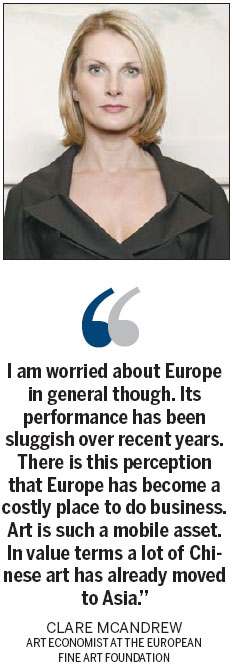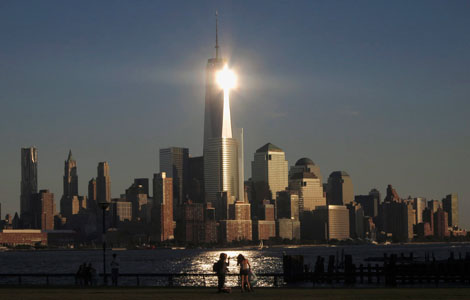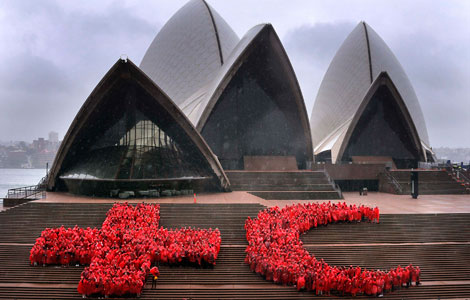

|
Many Chinese collectors fly to Europe or Hong Kong in search of a good bargain. Provided to China Daily |
European galleries, dealers chart strategies to attract Chinese buyers
Europe's galleries, dealers and auction houses are facing an uphill struggle to maintain a share of China's multi-billion-euro annual art investment in the face of competition from Hong Kong and a dramatic fall in spending.
A study for the European Fine Art Foundation, published in March, shows that Chinese spending on art and antiques dropped by nearly a quarter in 2012, after several years of growth had made China the biggest spender in the market.
"I think it's obviously a big slowdown," says Clare McAndrew, an art economist who compiled the annual report: "2012 in China was like 2009 in other countries. The economy slowed down a bit and people didn't think it was the time to sell their best pieces."
Europe has traditionally been an important center of Chinese art dealing, particularly in London and Paris. But there is a fear that even if China's art market recovers, a pivot toward Asia will leave the European market struggling.
 |
"I'm actually very positive for China in the medium to long term. Over the last year there was excessive speculation and some art funds had reached maturity. At the same time the Chinese government was cracking down on the tax side. It made people a bit more wary, but this shake-out can be a good thing for the market," McAndrew says.
"I am worried about Europe in general though. Its performance has been sluggish over recent years. There is this perception that Europe has become a costly place to do business. Art is such a mobile asset. In value terms, a lot of Chinese art has already moved to Asia."
Hong Kong has been emerging as the primary rival to European and North American Chinese art centers since the early 1980s, says Nicolas Chow, international head of Chinese ceramics and works of art at Sotheby's, which first opened in Hong Kong in 1973.
For certain types of pieces, particularly porcelain and objects made for the imperial court, Hong Kong is already the No 1 place to sell. But despite this general shift, Europe remains strong in certain areas of Chinese art.
"We try and give each center a certain specialty," Chow says. "For example, in New York we tend to sell the finest bronzes. In London there is a strong emphasis on Song Dynasty (960-1279) ceramics. Traditionally, English collectors are very keen on that area."
As a result, Sotheby's continues to hold major auctions of Chinese art in London and Paris, as well as New York.
"I would say there is not much downside to selling in London as the market has become so international," Chow says. "There are a large number of buyers, particularly dealers, who travel to every center.
"Those who buy an object in London are also buying an idea, a dream of buying something fresh out of the attic. To a lot of buyers there is something attractive to buying something that has never been on the market and comes fresh out of an old house. People sometimes buy over market price for that particular dream."
Colin Sheaf, chairman of Bonhams Asia, oversaw the British auction house's expansion into Hong Kong in 2007. He says that Europe remains an important center for Chinese art dealing, but that expanding into Asia was important to offer buyers more choice.
"I think it is fair to say Hong Kong is now the most important international center for the sale of Chinese art, and that means we are pitching in Asia against the major Hong Kong auction companies as it provides us with the best chance to grow our business," he says.
"I sold a vase at an auction in London for 9 million pounds ($14 million; 11 million euros) two years ago, which is the highest price ever paid in Europe for a piece of 18th century Chinese porcelain, so I think there is a place for London in this market.
"Europe has been very strong in the past. There are fewer collectors in Europe than there used to be as prices have risen and Chinese buyers have become the most important group, but nonetheless it remains an important center. Many collectors still love to come to London. If the objects are good enough, they will sell very happily there."
The challenge remains persuading Chinese buyers that it is still worth a journey to Europe in search of a bargain. The European Fine Art Fair in Maastricht, the world's leading fair of its sort, now actively courts Chinese investors.
"The Chinese collectors that come are generally traveling in small groups, accompanied by our Shanghai-based agent," says Titia Vellenga, marketing manager at TEFAF. "They receive access to our hospitality lounge, and this year we also hired a Chinese-speaking hostess for the lounge.
"We've had a Chinese-language website for five years and we've organized TEFAF presentations in Beijing and Shanghai. This year's annual global art market report is also currently being translated into Chinese."
Chinese art has also played an increasingly significant role in the annual Asian Art in London event, which showcases Asian art to collectors, dealers and the general public.







